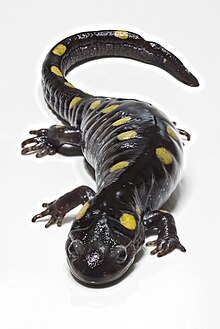Henry Street salamander tunnels

Henry Street salamander tunnels is a wildlife crossing which was built in 1987 to assist salamander migration in Amherst, Massachusetts. Before tunnels were built salamanders were often crushed by vehicles as they crossed Henry Street. The salamnders winter on the east side of Henry street and they cross to the west side in the spring so that they can breed in the Vernal pools that form. The salamanders that cross Henry Street are Spotted salamanders.
In the 1980s locals carried salamanders across Henry street in buckets to protect them from traffic. In 1987 a German company built tunnels under Henry Street to assist the salamander migration. The town also still uses volunteers to help any salamanders who miss the tunnel; they also temporarily close the street when the migration is underway. There are two tunnels spaced 200 ft (61 m) apart and they were the first amphibian tunnels in the United States.
Background[edit]
Henry Street is a two-lane street North Amherst, Massachusetts and Spotted salamanders cross the street to get to their breeding sites. In the spring after rain and when temperatures rise above 40 degreed Fahrenheit, salamanders come from underground. They begin to cross Henry Street to get to Vernal pools which form on the other side of the road.[1] Before volunteers began assisting the salamander crossing, it was common for passing vehicles run over the salamanders, which reduced their population.[2]
To facilitate safer salamander crossings, the town of Amherst, Massachusetts created tunnels under Henry Street so that migrating salamanders could cross the street to for breeding. Salamanders winter on the east side of Henry Street in the forest and they cross to the west side each spring.[3] The salamanders use the Vernal pools that form on the west side of Henry Street as breeding ponds.[1] There are two tunnels which are 10 in (250 mm) high and 6 in (150 mm) wide; there are slots in the roadway to allow moisture to leach into the tunnel system. In the forest there are long fences that lead salamanders and other amphibians toward the mouth of the tunnels.[1] The two salamander tunnels are spaced 200 ft (61 m) apart.[4] The tunnels were the first amphibian tunnels in the United States.[1][5]
History[edit]
In the 1980s local volunteers assisted the salamander crossing by what was referred to as a bucket-brigade. Volunteers waited along Henry street and they put migrating salamanders in buckets to carry them across the Street. In 1987 a German drainage company (ACO Polymer) heard the story about the locals assisting the salamander crossing and they paid for a tunnel project under Henry Street.[1][6] The Amherst Department of Public Works, University of Massachusetts, the Hitchcock Center for the Environment and the Massachusetts Audubon Society supported the project. It is estimated that between one and two hundred animals cross using the tunnels annually. Some salamanders that miss the tunnels cross the road and risk being crushed by vehicles on Henry Street so volunteers watch for them.[1] In 1988 fifty people came out to watch to migration when the tunnels opened.[7]
In 2024 the town of Amhearst announced that they would close Henry street for two days (February 28 and 29th, 2024) so that salamanders would not be run over by cars. The town also installed temporary signage to alert drivers.[3] The Hitchcock Center for the Environment partnered with the town to arrange for volunters to assist salamanders that do not use the salamander tunnels.[8] Many locals and college students watch the crossing each year.[2]
See also[edit]
- Bat bridge
- Culvert
- Habitat corridor
- Landscape connectivity
- Paseo del Jaguar
- Squirrel bridge
- The Pollinator Pathway
- Toad tunnel
- Urbanization
- Wildlife corridor
References[edit]
- ^ a b c d e f Hofherr, Justine (25 March 2015). "There Are Teeny Tiny Underpasses for Salamanders in Massachusetts". www.boston.com. Boston globe Media Partners, LLC. Retrieved 21 May 2024.
- ^ a b Wompa, Amalia. "Amherst's underground tunnels allow locals to watch salamanders migrate". Massachusetts Daily Collegian. Retrieved 21 May 2024.
- ^ a b DeGray, Nick (28 February 2024). "Salamander crossing: Drivers prepare to stop on Henry Street in Amherst". WWLP. Retrieved 21 May 2024.
- ^ Chambers, Neil B. (5 July 2011). Urban Green: Architecture for the Future. New York, New Yok: St. Martin's Publishing Group. p. 169. ISBN 978-0-230-33741-1. Retrieved 21 May 2024.
- ^ Defenders (64 ed.). Washington, DC: Defenders of Wildlife. 1989. p. 20. Retrieved 21 May 2024.
- ^ Andrews, Kimberly M.; Nanjappa, Priya; Riley, Seth P. D. (June 2015). Roads and Ecological Infrastructure: Concepts and Applications for Small Animals. Baltimore, Maryland: JHU Press. p. 193. ISBN 978-1-4214-1639-7. Retrieved 21 May 2024.
- ^ Poon, Linda (21 March 2013). "How to Help Animals Cross the Road (or Canal or Dam)". National Geographic Society. Retrieved 21 May 2024.
- ^ "Big Night 2024. Town Partners with Hitchcock Center to Help Annual Salamander Migration - Amherst Indy". Amherst Indy. 2 March 2024. Retrieved 21 May 2024.
